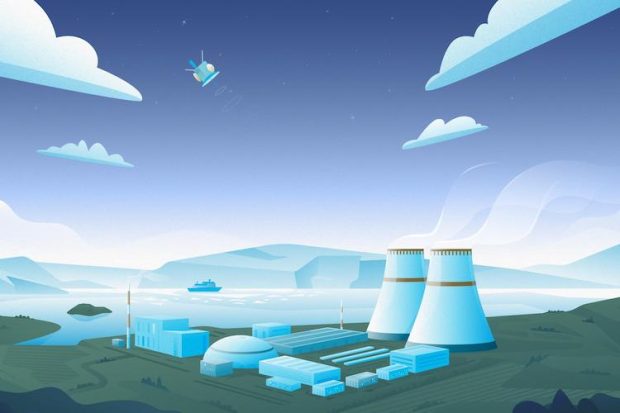Dysconnection Hypothesis of Schizophrenia
Neuroscientist Karl Friston on split personality, the nature of mental disorders, and the possibility of a the...
When two molecules collide, an atom or atoms can transfer from one molecule to the other and produce a new molecule. That process is known as a chemical reaction, and it’s a really important process: it occurs everywhere in biology, it’s crucial in industry… There are few things more important than chemical reactions. It’s very important for chemists to understand the mechanism of chemical reactions. When molecules collide, which atoms are going to transfer? What are the products? What are the reactants? How fast is that chemical reaction going to go?
Understanding the speeds of chemical reactions is the area of chemistry known as chemical kinetics. The crucial quantity that one really needs to know when you have chemical reactions is the rate of reaction or the rate constant of the chemical reaction. Many scientists and chemists spend their time measuring the rates of chemical reactions and looking at the products of the chemical reactions. The trouble is, quite often, doing experiments is quite a complicated and expensive process. Nowadays, in the modern world, there’s another way of finding the rates of chemical reactions without having to do an experiment at all, and that is to use theory and computers instead.
The crucial thing is that when one molecule collides with another, there’s a potential energy between them and that potential energy usually goes up to a maximum and comes down the other side. So if the molecules have enough speed, have enough kinetic energy, and that’s above the barrier of the reaction, the reaction will just go very quickly. But most reactions have this barrier, and quite often, the molecules don’t have enough kinetic energy to go over the barrier. So how does the reaction then occur? Well, you can still get a chemical reaction when kinetic energy is less than the barrier because the atoms can tunnel through the barrier; they can go from one side to the other. That is a remarkable effect: it’s an effect that arises out of quantum theory. It doesn’t come from Newton’s classical theory; it comes from quantum theory.
It’s just extraordinary: in principle, in quantum theory, I could just pass through a window in this room and get to the other side tunnelling through the barrier.
In practice, though, that doesn’t happen because the probability of tunnelling is so small. But when you get one molecule colliding with another, and you might have a hydrogen atom transferring from one molecule to another, there is quite a large probability of tunnelling through that barrier in quantum mechanics. So, a very important part of modern quantum chemistry and theoretical chemistry is to calculate the tunnelling probabilities. What’s the probability of passing through this barrier from one side to the other? And the theory that one uses is quantum mechanics.
Subsequently, his great competitor Max Born, another great scientist who was in Göttingen, thought he’d apply Schrödinger’s equation to collisions between atoms and molecules, something new. Born in that process, I realized that Schrödinger’s equations could be applied to collisions, and then others realized you could then apply it also to chemical reactions, to tunnelling through these barriers. So there’s an equation for atoms passing through these potential barriers, and you can solve Schrödinger’s equation and get the probability of going from one side of a chemical reaction to the other.
This is a very temperature-dependent process: if the temperature is very low, the energies of the molecules are very low, there’s a great big barrier, and the tunnelling probability is very small. If the temperature rises, the molecules move around more and then they can tunnel through the barrier just near the top of the barrier, and the tunnelling probabilities are very high. So, the rates of reaction are very temperature-dependent, and the tunnelling in chemical reactions through these barriers is very temperature-dependent. So one has to do these calculations solving Schrödinger’s equation many times: you solve it for low collision energies, higher collision energies and higher collision energies, and then you average over all those energies to get your rates of the chemical reaction.
A lot of chemists and scientists know that you can apply Schrödinger’s equation to calculate properties of atoms and molecules like infrared spectra, electronic spectra, thermodynamic properties like energy changes, etc… However, not many people know that you can solve Schrödinger’s equation to calculate the rates of chemical reactions.
And not just in the Earth’s atmosphere: another very important area is in astronomy, where you get molecules in outer space. It’s a fascinating area where the spectra of many molecules have been detected, especially by radioastronomy from interstellar space, the space between stars where there are many molecules. Those molecules can go on to have chemical reactions, and it’s very important to understand how molecules are formed in those conditions. They can have quite low temperatures in interstellar clouds.
So, one of the important applications of using quantum mechanics nowadays is to predict the rates of chemical reactions that can go on in astrophysical environments at low temperatures and sometimes at high temperatures. This is a very important area for the applications of quantum mechanics.
For example, a lot of people are interested in how do the organic molecules form where you get lots of carbon atoms. If you can explain that, you might be able to explain how molecules of life form where you’ve got carbon, nitrogen, oxygen, one or two other atoms, and how those sorts of molecules form.
Even how long carbon chain molecules form wasn’t really well known until, in my group and other groups, people started to do calculations on chemical reactions using quantum mechanics. We, in fact, found that if you get a carbon atom and react it with molecules like acetylene and ethylene, the reactions go very quickly, even at the very low temperatures of interstellar clouds. You can calculate the rates of those chemical reactions, and you can predict the sorts of molecules that are being formed, and then sometimes people can measure the spectra of those molecules and then relate that back down to the calculations that people have done.

Another big problem in astrophysics (in fact, one of the big fundamental problems in astrophysics) involves by far the most abundant molecule that there is: hydrogen, H2. Now, it’s known from the fundamental theories of astronomy that you get a lot of hydrogen atoms produced. The question is, how do the hydrogen atoms combine to form hydrogen molecules? If you get a hydrogen atom here and a hydrogen atom there, and they collide, they will vibrate for a little and always then fall apart.
So one thing that we did is look at this problem, and one thing you get in astronomy is you get a lot of what are known as interstellar grains, that is, small solid particles. They can be made of silicon; they can be made of oxygen… They can actually act as catalysts for chemical reactions. What catalysts do is that they bring down this barrier to a chemical reaction that I was talking about earlier. They have a crucial role, of course, in industry because they can allow chemical reactions to occur that wouldn’t otherwise occur. One thing we found is that if you put hydrogen atoms on surfaces, on solids like silicon oxides, then the grain, the silicon oxide can act as a catalyst, and the hydrogen atoms can come together: the catalysts can take the energy away from the hydrogen so it can produce H2. Then, the hydrogen can come off, and that is how H2 is formed.
The catalysts are very important in the industry: one of the most important processes there is producing ammonia from nitrogen and from hydrogen: N2 and H2. There’s a huge barrier to this process, but there are metal catalysts originally developed by Haber, the great German chemist, using iron. If you do that reaction with catalysts such as iron, you bring down the barrier, and the reaction can go. If you’ve got N2 plus H2, you could bring down the barrier, you can break nitrogen, and it can react with H2 to form NH, and then NH can react with H2 to form NH2, and then another hydrogen to produce ammonia, which has very important applications in agriculture and so. But all that comes back down to chemical reactions and using a catalyst to bring down the barrier in the chemical reaction.
All that can be calculated nowadays using Schrodinger’s quantum mechanics, and you can predict all those rates, and you can also predict very cleverly different types of catalysts. You could mix iron with ruthenium in different variations and get very efficient catalysts that you can calculate using the methods of quantum mechanics. So it’s quite extraordinary, really, that this fundamental theory, first of all, developed for the hydrogen atom by Schrödinger in 1926, can now be applied in a very useful way to many important industrial, environmental and other processes that people are interested in.

Neuroscientist Karl Friston on split personality, the nature of mental disorders, and the possibility of a the...

Physicist Michele Dougherty on the exploration of Jupiter’s moons, Europa’s ice crust and the internal ocean o...

Psychoneuroimmunologist Daisy Fancourt on the use of music in healthcare and its role in emotion regulation